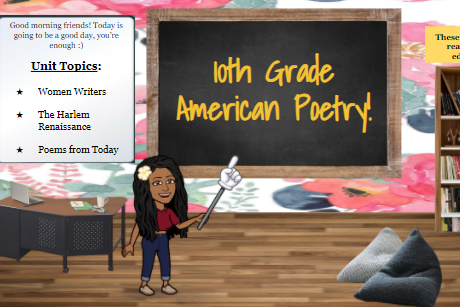I’ll be honest with you, friends. Like many, I went into this semester with a not-so-positive mindset. I immediately thought it would be really challenging for me to enjoy having my normal tag-teaming literature discussions online and was bummed about not being able to visit high schools this fall.
It can be hard to appreciate some of the work we are doing for our courses at a time like this, but I encourage you all to take a moment when writing that paper or relearning that section of math, and think about how far you’ve come.
– Daijah Patton
Everything was drastically different, and I couldn’t see the light at the end of this tunnel. When I first figured out that I wanted to be an English teacher, I knew I wanted to be the English teacher that everyone comes to for advice, vibes with, and makes you love reading and writing regardless of your past experiences with it. But I never thought in a million years that I would be trying to imagine that scene from my childhood bedroom. It almost felt unrealistic because of how Miss Rona has changed the entire experience and normal grid of education, but I found my perspective changing because of one really cool assignment.
Currently, in my junior year of the Secondary Education program, we are now beginning to hone in on all the skills and training that we have learned so far and will need before going into our semester before student teaching. It’s terrifying and exciting all at once, but that’s what I love about education; things are always changing. And because of that, I had a change of heart. There was a project in my Strategies for Emerging and Content Literacy course with Dr. Susan Silver that I found myself working tirelessly on because, well…I loved it! In this course, we learn about the importance of coming up with different strategies to teach students to read, write, and communicate effectively and do so by aiding all different kinds of learners. We’ve begun to grasp that literacy has multiple meanings, not just the ability to read and write. Literacy can apply to technology, comprehension of historical events, health, finance, and many other things.
Our midterm project was called a Curriculum Map, and, yes, it is exactly how it sounds: a map of a curriculum! We each picked a topic that we wanted to teach, the age group ranging from 7th to 12th grade, made a layout of how long the lesson plan would last, and constructed it with the help of the Pennsylvania Standards Aligned System, which is a website full of educational resources and lesson structures. Before we presented, we were asked to make a model of how we’d like our future classroom to look, and we got to incorporate our Snapchat Bitmojis in it, thus beginning my brainstorming.

Because I am crazy for poetry, I decided my unit would be on American Poetry for 10th grade, with three main topics: Women Writers, the Harlem Renaissance, and Poems from Today. Within each topic there would be a specified collection of poems that I would assign students to read and understand, and after completing each topic, we would have a cool activity to indulge in. My professors have always stressed to us the importance of engaging students in an activity of sorts to show what they’ve learned, and more importantly, to make that learning fun. My favorite activity, which I constructed with the help of the teacher web was an escape room for the Harlem Renaissance! Students would be confined to different parts of the classroom and would only be able to “escape” if they could collaborate with their peers, and provide the answers to questions about the history of the writers who contributed to the Renaissance.
Although I had to present the map through a Zoom call, the support from my classmates and my professor, and constructive feedback I received on ways to improve the curriculum, were extremely helpful. This project is something that I am super proud of and hope to use in my future classroom someday, and I will definitely be doing that escape room! This course and project has taught me so much about ways to approach teaching inclusively, passionately, and creatively, and I can’t wait to put these skills to use with the next generation of students. If you’d like to view my presentation, here is the link.
I know it can be hard to appreciate some of the work we are doing for our courses at a time like this, but I encourage you all to take a moment when writing that paper, making that piece of art, relearning that section of math, or finishing that science lab, and think about how far you’ve come. Think about how these assignments and projects will eventually prepare you for the career you want to pursue, and how ready you’ll be. I’m only a junior, and I am so excited to be part of the impact that education brings.



